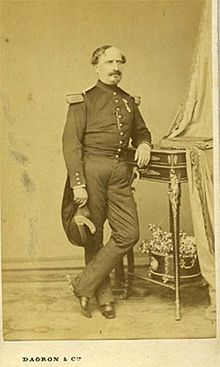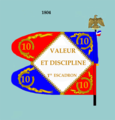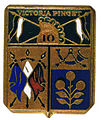10 e régiment de dragons
|
Régiment Le Tessé dragons |
|
|---|---|
 Internal association badge |
|
| active | 1674 to 1962 |
| Country |
|
| Armed forces |
|
| Armed forces |
|
| Branch of service | dragoon |
| Type | Cavalry Regiment |
| Patron saint | Maurice d'Agaune |
| motto | "Victoria pings" |
| Anniversaries | May 5, 1863 |
| Awards | Croix de guerre 1914–1918 with two palm branches |
| commander | |
| commander | Last: Colonel Collot |
| Important commanders |
|
The Régiment La Tessé Dragons - last 10 e régiment de dragons ( 10 e RD ) was an association of French cavalry, which was set up on March 25, 1674 by the Comte René de Froulay de Tessé. In 1685 it was named Régiment Mestre de Camp Général Dragons and then in 1791 the name "10 e régiment de dragons". Between 1811 and 1815 it was called 5 e régiment de chevau-légers lanciers. The unit was dissolved in 1962.
Formation history
Da Régiment Tessé Dragons was set up by René III de Froulay, Comte de Tessé on March 25, 1674. Tessé had previously bought the (non-active) post of “Général des carabiniers” from Comte Louis de Quincé for 40,000 livres . On December 17, 1684, de Tessé received the rank of Mestre de camp general des dragons from the king . Thereupon, from 1685 onwards, his regiment was named "Régiment Mestre de camp général dragons"
In the course of the French Revolution , all regiments lost their names and since January 1, 1791 have only been designated by numbers. In doing so, attention was no longer paid to the preceding, socially not insignificant ranking. The regiment, which had previously ranked second behind the Régiment dragons Colonel Général , was placed in 10th place.
During the First Empire , the "10 e régiment de dragons" was renamed on June 18, 1811 to 5 e régiment de chevau-légers lanciers .
On August 1, 1815, King Louis XVIII. the imperial army formally and without pay. On November 21, 1815 the "5 e régiment de chevau-légers lanciers" was dismissed.
When the royal army was re-established in 1816, the regiments were named after the name of Départements. The previous "10 e régiment de dragons" was set up again and was given the name "Dragons de la Seine".
Under King Charles X , the "Régiment dragons de Seine" was dissolved in 1825 and reorganized as the 10 e régiment de cuirassiers . At the same time, the “22 e régiment de chasseurs à cheval” in the Vendée was converted into a new “10 e régiment de dragons”.
In 1939 the "10 e régiment de dragons" was dissolved and formed the tribe for five newly established "Groupes de reconnaissance" (reconnaissance groups).
It was re-established under the old name on April 16, 1945, followed by renewed dissolution on November 1, 1945.
Again set up on May 15, 1956, the unit was finally disbanded on October 31, 1962.
Mestres de camp / Colonels / Chefs de brigade
Mestre de camp was the rank designation for the regimental owner and / or the actual commander. Should the Mestre de camp be a person of the high nobility who had no interest in leading the regiment (e.g. the king or queen), the command was given to the Mestre de camp lieutenant (or Mestre de camp en second). The name Colonel was used from 1791 to 1793 and from 1803, from 1793 to 1803 the name Chef de brigade was used . From 1791 there were no more regimental owners.
Mestres de camp généraux (regimental owner)
- 1674. René de Froulay de Tessé. After the formation, his younger brother Philibert-Emmanuel de Froulay de Tessé was a major in the regiment.
- 1691: Louis, comte de Mailly
- May 11, 1696: Antoine V. de Gramont
- March 25, 1703: Gabriel-Étienne-Louis Texier, Marquis d'Hautefeuille
- July 5, 1709: Charles-Louis-Auguste Fouquet, Maréchal de Belle-Isle.
- July 9, 1736: Marie-Charles-Louis d'Albert, Duc de Luynes, Duc de Chevreuse
- January 24, 1754: François-Henri de Franquetot de Coigny.
- October 1771: Louis-Joseph-Charles-Amable d'Albert de Luynes.
- 1789: François-Marie-Casimir de Franquetot, Marquis de Coigny.
Colonels, Chefs de brigade and Chefs d'escadrons
- 1791: Colonel Chevalier Joseph-Mercure d'Estresses
- 1792: Colonel Joachim-Joseph Neuilly
- 1792: Colonel Jean-Louis La Roque
- 1793: Chef de brigade Antoine-François Pierson
- 1795: Chef de brigade Jean-Baptiste Godard, chef de brigade
- 1800: Chef de brigade Jacques-Marie de Cavaignac
- 1806: Colonel Jean-Baptiste Dommanget
- 181: Colonel Francois-Félicité Chabert
- 1814: Colonel Louis-Claude Chaillot
- 1867/68: Colonel Jean Françoise de la Filolie de la Reymondine
- 1907: Colonel Billet
- 1914: Colonel Jochaud du Plessix
- 1917: Colonel Menu du Mesnil
- On January 10, 1918, after Colonel Menu du Mesnil's departure, the regimental staff was dissolved and the regiment was divided into two independent groups with two escadrons each until January 1919.
- On February 10, 1919, Colonel Devanlay took over the regiment.
- 1938: Colonel Desprez
- 1956: Lieutenant-Colonel Viard
- 1960: Lieutenant-colonel d'Achon
- 1961: Chef d'escadrons Issaverdens
- 1961: Lieutenant-Colonel Rostain
- 1961: Chef d'escadrons Bouland
- 1961: Chef d'escadrons Henriot
- 1962: Lieutenant-Colonel Perrier
Battle calendar
Ancien Régime
From mid-August 1674 to the beginning of 1675 the regiment was in Roussillon , where it belonged to Friedrich von Schomberg's troops .
In April 1675, the regiment was scheduled for a punitive expedition to Messina , but was then relocated to the Guyenne province to suppress the so-called "Révolte du papier timbré" . At the end of August the regiment was then in Brittany and from November 17 to December 31, 1675 in Bordeaux .
During the War of the Palatinate Succession , the Comte de Tessé was the relentless executor of the orders of War Minister Louvois , which led to the second devastation of the Electoral Palatinate.
Then the regiment fought under Nicolas de Catinat on May 28, 1690 in the Battle of Avigliana , on August 18, 1690 in the Battle of Staffarda and on October 4, 1693 in the Battle of La Marseille ( Piedmont ).
During the War of the Spanish Succession , it fought on September 20, 1703 in the battle of Höchstädt .
During the War of the Austrian Succession , it took part in the invasion of Bohemia in 1741 . On June 27, 1743, the unit fought in the Battle of Dettingen . She was then transferred to Flanders, where she took part in the Battle of Fontenoy on May 11, 1745 .
During the Seven Years' War , the title of "Mestre de camp général" passed to the nineteen-year-old François-Henri de Franquetot, Duc de Coigny. However, experienced officers continued to command:
- until March 27, 1761 the Lieutenant-Colonel Gabriel Augustin de Franquetot, Comte de Coigny
- from March 28, 1761 the Lieutenant-Colonel Jean Charles, Marquis de Ville
The regiment fought on July 26, 1757 in the Battle of Hastenbeck and on June 23, 1758 in the Battle of Krefeld .
French Revolution and First Empire

Campaigns
- 1792–1794: Assigned to the Armée du Nord (1791 - Northern Army) and Armée des Ardennes (Ardennes Army)
- 1794: Armée de Sambre-et-Meuse (Sambre and Maas Army)
- 1795–1797: Armée de Rhin-et-Moselle (Rhine and Moselle Army)
- 1799: In the Netherlands
- 1800–1801: With the "Armée des Grisons" (Army of Graubünden)
- 1802: Expedition to Santo Domingo
- 1805–1807: With the Grande Armée
- 1806–1807: Campaign to Prussia and Poland
- 1809–1811: Spanish War of Independence
Combat activities
- 1792
- 1793
- Battle of Neerhaben ,
- Counterrevolution in Cambrai
- 1794
- Battle of Fleurus (1794)
- Battle of Sprimont
- Siege of Koblenz
- 1795
- Siege of Mainz (1794–1795)
- on Mont-Tonnerre
- 1796
- 1799
- Battle of Bergen
- Battle of Alkmaar
- Battle of Castricum .
- 1800
- Crossing over the Splügen Pass .
- 1805
- 1806 campaign in Prussia and Poland
- Battle of Jena Since the regiment was used to pursue Prussian troops and then in the battle near Boizenburg and Prenzlau , it did not take part in the battle.
- 1807
- Battle of Eylau (Ordre de bataille: under the command of Colonel Jean-Baptiste Dommanget, the regiment will take part in the great cavalry attack. (10,000 -12,000 horsemen). The leadership is with Maréchal Joachim Murat .)
- 1809
- Battle of Alba de Tormes
- 1810
- Siege of Ciudad Rodrigo
- 1811
1815-1914
- 1832: Used in the Belgian Revolution
- 1870: Participation in the Franco-German War . At the siege of Strasbourg in the fortress.
First World War
1914
- Lorraine
- August 23rd Battle of Gerbéviller
- August 25th and 26th: Battle at Rozelieures
- First battle of the Marne
- September 4th: at Saint-Barthélémy
- September 9: at Château-Thierry
- September 12: at Fismes
- September 13: near Craonne
- September 23: near Chaulnes, Péronne
- September 24th: near Dompierre
- September 27: at Miraumont
- Fight in the Artois
- October 9 at Wingles
- October 10 at Vermelles
- October 19th at Le Maisnil-Fresnoy
- First Battle of Flanders
- November 1st at Dranouter
- November 7th dismounted in trench warfare near Messines
1915 and 1916
After being assigned to Alsace in December 1914, the regiment was in the Aspach section until May 1916 , then Michelbach (Haut-Rhin) , Burnhaupt, Balschwiller , Fulleren and Pfetterhouse .
1917
- Battle of the Chemin des Dames
- April 6 - May 15: Trench warfare at Les Cavaliers de Courcy
1918
Interwar period
The regiment was garrisoned in Alençon in 1923 , then in Dinan and in 1936 in Orange .
Second World War
In the event of mobilization, the cavalry was intended to form reconnaissance groups (Groupes de Reconnaissance). When war was declared, the "10 e régiment de dragons" was therefore dissolved and formed the trunk for five reconnaissance groups.
- 21 e groupe de reconnaissance de corps d'armée (21 e GRCA)
- 5 e groupe de reconnaissance de division d'infanterie (5 e GRDI)
- 26 e groupe de reconnaissance de division d'infanterie (26 e GRDI)
- 34 e groupe de reconnaissance de division d'infanterie (34 e GRDI)
- 72 e groupe de reconnaissance de division d'infanterie (72 e GRDI)
After the regiment was re-established in Orange (Vaucluse) on April 16, 1945 , it was disbanded on November 1, 1945.
Algerian war
- June 1956: on the coast east of Aïn Témouchent
- October 14, 1957: in the El Malah / Rio Salado region
- from October 27, 1958: operations at Saïda , Aflou, Béni Saf, Méchria and Rouïba
- March 1, 1959 - February 11, 1962: Operations at Tiaret , Frenda, Aflou, Trezel, Ain Kermes, Laghouat , Djelfa and Maghnia .
Actions in honor of the regiment
- November 6, 1792, (Battle of Jemappes): the 10th e régiment de dragons was able to penetrate a field fortification (redoubt) held by the Austrians.
- June 26, 1794 (Battle of Fleurus): the regiment took a decisive action
- June 14, 1807 (Battle of Friedland): successful attacks
- June 9, 1918 (Battle of the Aisne): Defense of Plémont and the Saint-Claude plateau
Standard
The regimental standard bears, in gold letters, the names of the battles in which the regiment fought gloriously.
- Valmy 1792
- Fleurus 1794
- Austerlitz 1805
- Eylau 1807
- Friedland 1807
- Artois 1914
- Le Matz 1918
- AFN 1952-1962
Former uniforms
Association badge
1938-1939
Designed by Colonel Desprez
A three-part coat of arms in the French style, in the upper field on a green background a golden dragoon helmet with the 10 for the regimental number. Underlaid two crossed lances with green and white lance flags. Above the inscription: Victoria pinged. In the lower right field on a golden background three standards each in the color blue, white and red. In the lower left field the coat of arms of the city of Orange, garrison until 1938.
1945
The coat of arms of those of Tessé
1956-1952
The same badge was worn as in 1939, with minor changes.
Motto
The regiment's motto since 1684 has been:
- Victoria pings (He beautifies himself with victory)
This motto was also on the standard of the regiment "Mestre de Camp Général"
Known members of the regiment
- Maréchal de France René de Froulay de Tessé .
- Maréchal de France Antoine V. de Gramont
- Maréchal de France Charles Louis Auguste Fouquet de Belle-Isle
- Maréchal de France François-Henri de Franquetot de Coigny
- Général Jacques-Marie de Cavaignac .
- Général Justin Laffite (joined the regiment as a simple dragoon on September 8, 1789).
- General Alexandre d'Alton .
- Général Jean-Baptiste Dommanget
- Maréchal de camp François Joseph Marie Clary as Sous-lieutenant in the regiment on March 12, 1804
Individual evidence
- ↑ German: 10th Dragoon Regiment
- ↑ Not to be confused with the "Regiment Mestre de Camp Général Cavalerie" - which was a cuirassier regiment
- ^ Arnaud Bunel, "Regiment Mestre de camp Général Dragons", sur drapeaux.org .
- ↑ Louis de Quincé (son of Joachim de Quincé, died 1659 in Madrid), Count of the Holy Roman Empire , Mestre de camp , général des carabins, Governor of Domfront .
- ↑ Dr. Hoefer (dir.), Nouvelle biography générale depuis les temps les plus reculés jusqu'à 1850–1860, Firmin Didot, 1864, t.XLIII, 1034.
- ↑ Saint-Simon , Mémoires, coll. "Bibliothèque de La Pléiade", Gallimard, 1953, pp. 305-306.
- ^ "Avant-Propos", Historique du 10e régiment de dragons: 1914–1918, sur tableaudhonneur.free (PDF; 296 kB).
- ^ "10e regiment de dragons", sur cavaliers.blindes.free .
- ↑ Major was not a rank, but a job title for the head of the regimental administration
- ↑ The comte de Tessé then procured him his own regiment on August 4, 1681, the “Bursard Dragons”, later “20th régiment de dragons” Treuttel et Würtz, in the Mémoires et Lettres du maréchal de Tessé, Paris, Strasbourg, Treuttel et Würtz, 1806, pp. 5-8
- ^ "Marie François Henri, duc de Coigny de Franquetot", sur gw4.geneanet.org .
- ^ "Dragons", on napoleon-series.org .
- ↑ Between 1793 and 1803 the rank of Colonel was replaced by Chef de brigade
- ↑ Martial Lopez, Historique du 10e regiment de dragons: 1914–1918, sur tableaudhonneur.free (PDF; 296 kB).
- ↑ Lieutenant-Colonel Claude Aicardi "fiche Algérie 1954-1964 du 10e Dragons" sur cavaliers.blindes.free.fr
- ↑ Treuttel et Würtz.
- ^ A revolt against tax policy
- ↑ Émile Laloy, La Révolte de Messine: l'expédition de Sicile et la politique française en Italie (1674–1678) , Klincksieck, 1929, p. 48.
- ↑ Yvon Garlan, Claude Nières, Les Révoltes bretonnes de 1675: paper timbré et bonnets rouges, coll. “Problèmes / Histoire”, Éditions sociales, 1975, pp. 153–154.
- ↑ Archives historiques de la Gironde, 1906, p. 256.
- ^ Claude Larronde, "Les Officiers vicquois sous le règne de Louis XIV", in claude.larronde.pagesperso-orange.fr .
- ↑ Burnhaupt-le-Haut and Burnhaupt-le-Bas are 1.5 kilometers apart
- ↑ Décision n ° 12350 / SGA / DPMA / SHD / DAT du 14 September 2007 relative aux inscriptions de noms de batailles sur les drapeaux et étendards des corps de troupe de l'armée de terre, du service de santé des armées et du service des essences des armées, Bulletin officiel des armées, n ° 27, 9 November 2007 (regulation n ° 12350 / SGA / DPMA / SHD / DAT of September 14, 2007 on the appearance of the inscriptions on the flags and standards of the army, des Medical Service and the Fuel Supply Industry Published with the Official Army Bulletin No. 27 of November 9, 2007
- ^ Order AFN 1952–1962 on the assignment of the inscriptions on the flags and standards of the formations of the army and the services of November 19, 2004 (A) NORDEF0452926A Michèle Alliot-Marie)
- ↑ heraldically seen!
- ^ "Cavaignac Jacques Marie, general vicomte de Baragne (1773-1855)", sur appl-lachaise.net .
- ↑ A. Robert, G. Cougny, Dictionnaire des parlementaires français de 1789 à 1889, Bourloton, 1889-1891.
Web links
- 1756: registre des Dragons composant le regiment Mestre de Camp Général. In: ancestramil.fr .
literature
- Jean-Marie Déguignet, Histoire de ma vie , éd. At Here, 2000.
- Historique du 7e de ligne depuis sa formation , SHAT, 4 M 7
- Alexandre Adler, Historique du Régiment de Champagne , monographie couvrant la période du XVIe jusqu'à 1956.
- Archives militaires du Château de Vincennes.
- Recueil d'historiques de l'Infanterie française (général Andolenko - Eurimprim 1969).
- Louis Susane "Histoire de l'ancienne infanterie française" J. Corréard 1850
- Lieutenant Charles-Alexandre-Marie-Céleste d'Ollone, Historique du 10e régiment de dragons, Berger-Levrault, 1893.
- Martial Lopez, Historique du 10e régiment de dragons résumé pendant les cinq campagnes contre l'Allemagne: 1914–1918, sur tableaudhonneur.free (PDF; 296 kB), éd. abrégée, Montauban, Georges Forestié, 1920.















